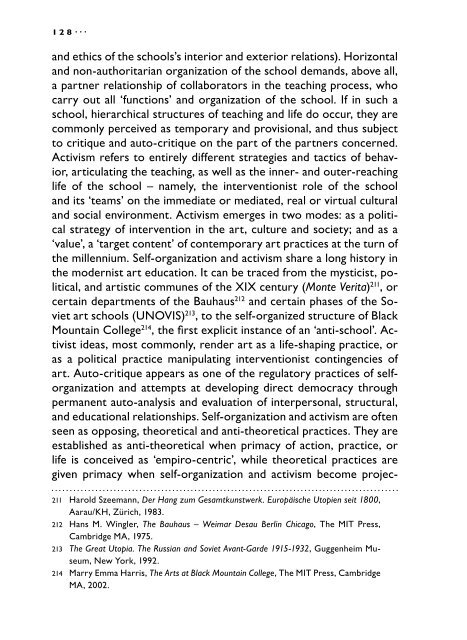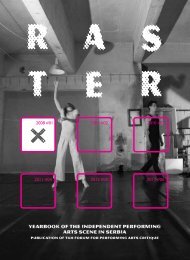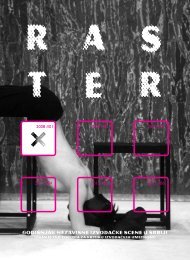Miško Šuvaković Epistemology of Art - TkH
Miško Šuvaković Epistemology of Art - TkH
Miško Šuvaković Epistemology of Art - TkH
You also want an ePaper? Increase the reach of your titles
YUMPU automatically turns print PDFs into web optimized ePapers that Google loves.
128··· ··· 129<br />
and ethics <strong>of</strong> the schools’s interior and exterior relations). Horizontal<br />
and non-authoritarian organization <strong>of</strong> the school demands, above all,<br />
a partner relationship <strong>of</strong> collaborators in the teaching process, who<br />
carry out all ‘functions’ and organization <strong>of</strong> the school. If in such a<br />
school, hierarchical structures <strong>of</strong> teaching and life do occur, they are<br />
commonly perceived as temporary and provisional, and thus subject<br />
to critique and auto-critique on the part <strong>of</strong> the partners concerned.<br />
Activism refers to entirely different strategies and tactics <strong>of</strong> behavior,<br />
articulating the teaching, as well as the inner- and outer-reaching<br />
life <strong>of</strong> the school – namely, the interventionist role <strong>of</strong> the school<br />
and its ‘teams’ on the immediate or mediated, real or virtual cultural<br />
and social environment. Activism emerges in two modes: as a political<br />
strategy <strong>of</strong> intervention in the art, culture and society; and as a<br />
‘value’, a ‘target content’ <strong>of</strong> contemporary art practices at the turn <strong>of</strong><br />
the millennium. Self-organization and activism share a long history in<br />
the modernist art education. It can be traced from the mysticist, political,<br />
and artistic communes <strong>of</strong> the XIX century (Monte Verita) 211 , or<br />
certain departments <strong>of</strong> the Bauhaus 212 and certain phases <strong>of</strong> the Soviet<br />
art schools (UNOVIS) 213 , to the self-organized structure <strong>of</strong> Black<br />
Mountain College 214 , the first explicit instance <strong>of</strong> an ‘anti-school’. Activist<br />
ideas, most commonly, render art as a life-shaping practice, or<br />
as a political practice manipulating interventionist contingencies <strong>of</strong><br />
art. Auto-critique appears as one <strong>of</strong> the regulatory practices <strong>of</strong> selforganization<br />
and attempts at developing direct democracy through<br />
permanent auto-analysis and evaluation <strong>of</strong> interpersonal, structural,<br />
and educational relationships. Self-organization and activism are <strong>of</strong>ten<br />
seen as opposing, theoretical and anti-theoretical practices. They are<br />
established as anti-theoretical when primacy <strong>of</strong> action, practice, or<br />
life is conceived as ‘empiro-centric’, while theoretical practices are<br />
given primacy when self-organization and activism become projec-<br />
211 Harold Szeemann, Der Hang zum Gesamtkunstwerk. Europäische Utopien seit 1800,<br />
Aarau/KH, Zürich, 1983.<br />
212 Hans M. Wingler, The Bauhaus – Weimar Desau Berlin Chicago, The MIT Press,<br />
Cambridge MA, 1975.<br />
213 The Great Utopia. The Russian and Soviet Avant-Garde 1915-1932, Guggenheim Museum,<br />
New York, 1992.<br />
214 Marry Emma Harris, The <strong>Art</strong>s at Black Mountain College, The MIT Press, Cambridge<br />
MA, 2002.<br />
tions <strong>of</strong> theory-derived concrete utopias, and (also) when practice<br />
is understood as a mode <strong>of</strong> theoretical work which needs to be subjected<br />
to theoretical analysis. These three paradigms are <strong>of</strong>ten confronted.<br />
Self-organizing schools are subject to conflicts and mutual<br />
differentiation and, therefore, <strong>of</strong>ten short-lived.







